Bupa

The insurance sector is a major component of the economy due to the number of installments it collects and the size of its investments, and most importantly, the basic social and economic role that it plays by covering personal and commercial risks. In common with other sectors, the insurance sector had to face the direct and indirect consequences of COVID-19 on the daily life and health of the people and the economy in 2020, as insurance companies witnessed a slowdown in insurance premiums in 2020 compared to 2019.
In recent years, the sector has suffered from a group of factors, some of which are directly under the control of insurance companies, and a group of external factors that go out of their control, as the sector has faced throughout the past two decades great difficulties to generate returns that exceed the cost of capital, and the importance of the global insurance sector has declined for investors gradually, due to the lack of returns, weak growth and extreme profit fluctuations, in addition to the lack of clarity of risks and sources of profit and value, also because the companies lack the flexibility of performance, as the value of the most prominent American life insurance companies compared to their counterparts in the financial services sector decreased from 40% in 1985 to 17% and 9% For 2005, and 2020 respectively.
Overall, the increase in interest rates and the strong performance of financial markets in 2021 contributed to an improvement in insurers’ solvency.
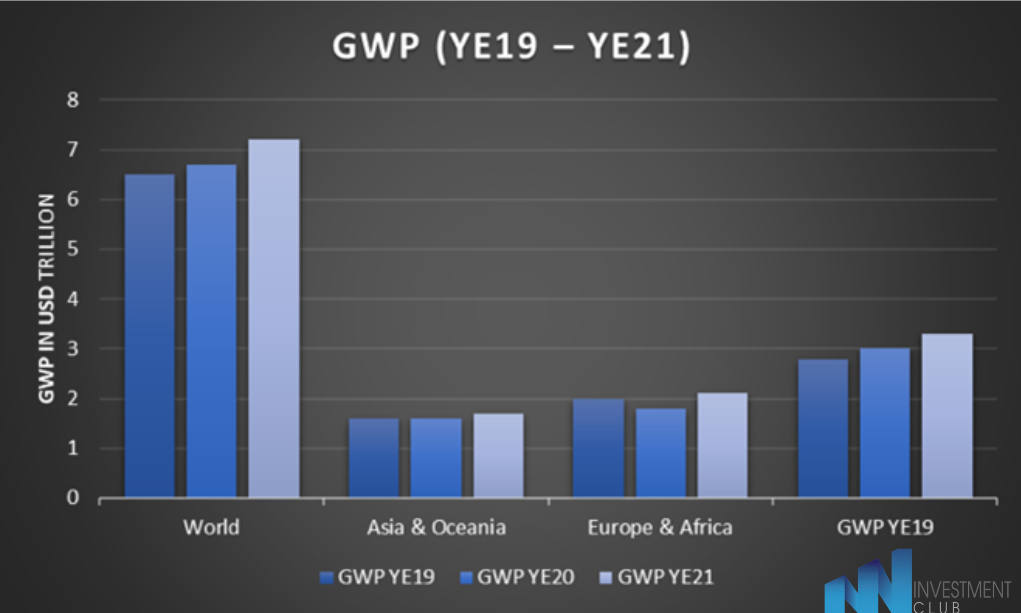
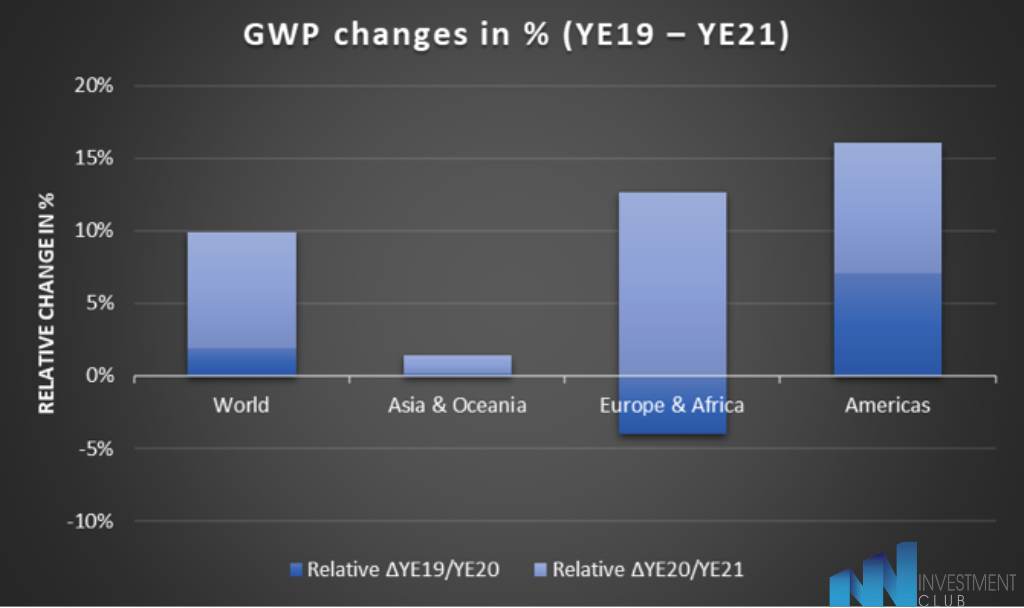
Overall, that shows gross written premiums covered by the SWM increased by 8% at year-end 2021 compared to year-end 2020, which is significantly higher than the increase of 1.9% when year-end 2020 is compared to year-end 2019.
Here is an illustration of the decline in surplus assets over liabilities in the last three years.
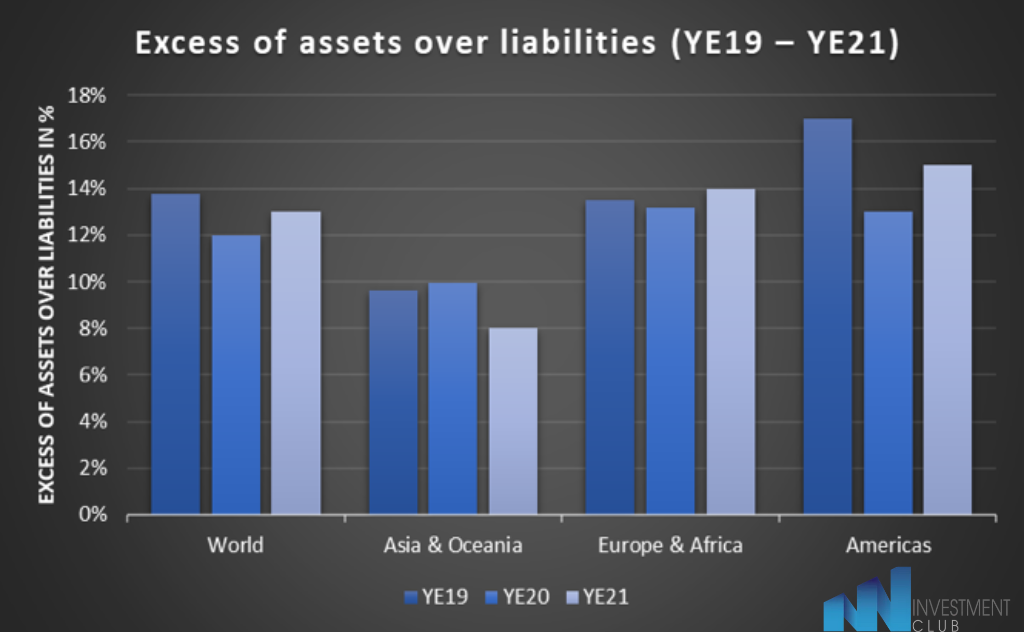
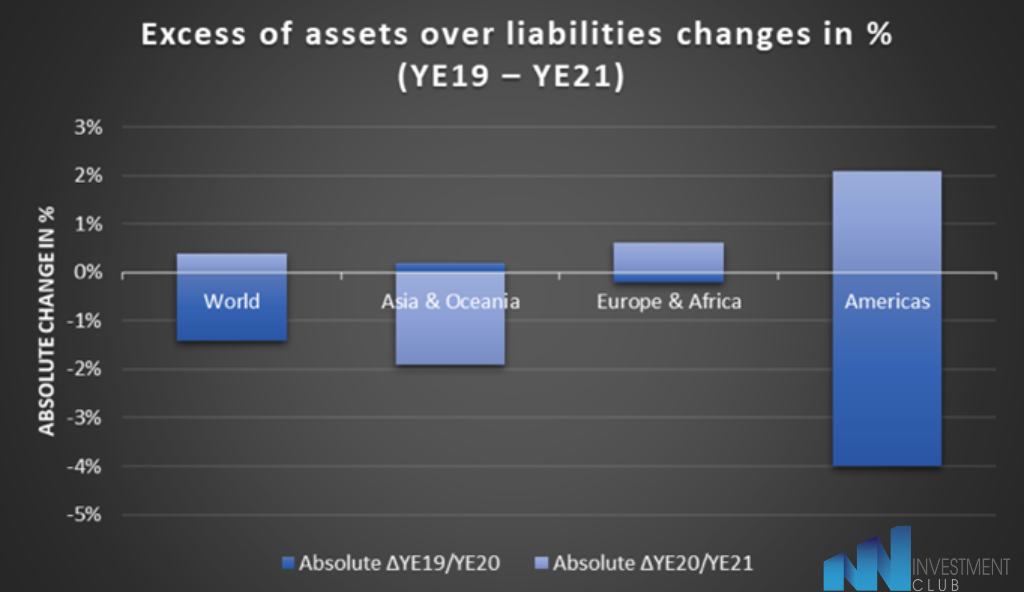
The insurance sector in the Kingdom of Saudi Arabia compared to the size of the economy is not at the level that the Kingdom aspires to, in terms of the size of the companies present in the market nor from the insurance products offered. Insurance in the Kingdom provides vehicle insurance, property, protection and savings, and health insurance. But in line with the Vision 2030, the Kingdom aspires to enhance the sector's growth, it has huge investment opportunities that will help achieve high targets such as raising local production and creating qualitative job opportunities. The Kingdom's first steps in achieving this is the establishment of an organizational authority for the insurance sector, and His Excellency the Minister of Finance stated during the Saudi Insurance Symposium.
The field of health insurance is expected to reach more than 60 billion riyals in 2030, escalating from 22 billion riyals in 2020. Professor Tal Nazer, CEO of Buba Arabia, and a member of the Strategic Health Insurance Committee of the Health Insurance Council, also stated the growth of investments in the health insurance sector exceeded 165 billion riyals, and this was reflected in the growth of the sector, as 5800 health facilities were established.
A more accurate view of the insurance sector in the Kingdom of Saudi Arabia, and despite the short period of time, the health insurance sector witnessed tremendous and very rapid leaps, the market size in 2005 was approximately one billion and 300 million only to 25 billion riyals in 2021, that is, more than 19 times doubled in only 17 years. The number of beneficiaries of health insurance coverage reached about 11.3 million people, and the claims paid from insurance companies reached about one billion riyals in 2005 to more than 20 billion riyals in 2021 in addition to the total medical claims paid from insurance companies from 2005 until 2021 from 172 billion riyals, where the health insurance sector doubled in 2021 to 60% of the market size after it was only 27% in 2005, and thus became the largest insurance product in the Saudi market, including 24 health insurance companies. It is expected that the health insurance sector will contribute to the GDP raising it up to 2% at the end of the 2030.
The significant growth and development in the health insurance sector in recent years is due to the Kingdom's efforts in light of the Vision 2030 and its allocation is a program to develop the health sector seeking to organize and remove all obstacles to the growth of the sector, and by fading these obstacles, the five largest health insurance companies in Saudi Arabia acquired more than 80% From the market, which is a normal percentage that approaches its counterparts in the countries of the world. For example, the five largest companies in Britain acquired more than 90% of the insurance market there, and investments in the health insurance sector reached more than 165 billion riyals, reflected in the growth of the sector.
According to what was mentioned in the reports of the third quarter of 2022 issued by the Saudi Central Bank, the insurance sector witnessed an increase in the total insurance premiums subscribed to a growth rate of 31.9% compared to the similar quarter of the previous year and in particular, the sector witnessed an increase in the total premiums subscribed to health insurance at a rate of 26.5% both health insurance and vehicle insurance continued to record high retaining rates, at a growth rate of 7.98% for health insurance, and the total health insurance premiums subscribed to them amounted to 7,589.5 million during the third quarter of 2022.
According to what the Saudi Central Bank report indicated, the distribution of premiums subscribed to them according to the type of insurance as follows, as the share of insurance was in favor of health insurance of 60.7%, followed by vehicles with 19.6%, then other general insurance types by 15.8% and finally protection and saving insurance of 3.8%. The depth of insurance to GDP during the third quarter of 2022 was 1.26%, with the share of health insurance being 0.73%, the highest share among other types of insurance. The depth of insurance to non-oil domestic product was 2.13%. The share of health insurance was 1.24%, the highest share.
The profitability of the sector during the third quarter was 449.7 million Saudi riyals.
Overall, the insurance sector experienced growth and profits compared to previous years and the comparable quarter of the previous year's third quarter.
After highlighting the company's main sector, we move to take a look at Bupa:
Bupa Arabian is a Saudi joint stock company specializing in the field of health insurance, which was established on the basis of Royal Decree No. 74/M of 29/08/1428H corresponding to 11/09/2007.
Bupa seeks to be a partner in healthcare for its customers and to be distinguished by providing high-quality services and the best healthcare facilities to customers to create a more comfortable experience.
Its most prominent business is the provision of health insurance products and services that meet the needs of companies in Saudi Arabia, government institutions, small and medium enterprises, and all their employees.
Bupa's services and products include lifelong health care, starting from the prenatal stage, then through maternity, and through later stages of life, where it works to provide a healthier life for its customers through carefully designed programs such as "Tebtum" and Your "Rahatkum". With their determination and commitment to quality, they have achieved exceptional growth over the years, with Bupa Arabia's health insurance becoming the choice of many in Saudi Arabia.
Bupa offers a wide range of health insurance programs and products that are designed to meet different needs, whether for companies or small and medium enterprises, also for individuals wishing to insure them and their families as well as for domestic labour.
Business Products:
1- Insurance for SMEs
The needs of SME owners vary, because each field needs various health insurance options, and by appropriate solutions covering all different needs and budgets. Therefore, Bupa Arabia has provided three different health insurance programs in Pumba facilities: Basic, Classic, and Excellence.
2- Insurance for companies with more than 200 employees
Bupa offers sophisticated options covering four categories of corporate health insurance coverage: Blue, Bronze, Silver, and Gold. It covers different levels of coverage caps as well as various levels of hospital and clinic networks.
3- Bupa Arabian International Health Care Programme
Bupa is interested in its customers no matter how far they travel. Bupa International Partnerships enables them to access health care through the largest health insurance network in more than 190 countries around the world.
This program is specifically designed to meet the needs of local and international health insurance for businessmen, businesswomen, and executives who work or reside in Saudi Arabia and abroad.
Family Products:
1- Bupa Family
Bupa takes care of the family's comfort and various health needs. Bupa Family Insurance is designed to provide Saudi families with a wide range of coverage plans based on their needs and appropriate prices.
2-Bupa Helpers
The Bupa product helps protect the health of domestic workers that is reflected in the protection of the whole family, where the family can obtain medical insurance for maids, drivers, as well as gardeners and everyone who helps care for the family. The software provides two different coverage to suit the diversity of needs, namely: classic and basic coverage.
3-Aramco Family
Bupa works to provide special care for the families of Aramco employees by providing exclusive health coverage for them in four different categories: Silver, Gold, VIP, and VVIP.
4-Program for parents
Bupa is one of the first companies to provide a health insurance program for parents, seeking to provide the same comfort and security to the parents of its members with three distinct health coverage: Silver, Gold, and VIP.
Bupa Arabian seeks to provide the best health care for its customers and their families, so not only does it provide various health insurance services, but it also works permanently to provide integrated health care by providing several distinctive programs.
1-Bupa Tebtom (Tebtom Program)
The Tebtom program provides a range of outstanding services to always provide the best and most comprehensive health care by specialized doctors who work to answer all inquiries and provide advice and guidance to customers through phone or Bupa app and website. The programme provides six health services:
- -Bupa Doctor
- - Pregnancy and maternity care
- - chronic care
- - International Consulting
- - Wellness services
- - vaccination
2-Bupa Rahatkom (Rahatkom Program)
Rahatkom program is designed to make hospital visits comfortable and easy by providing them with support when they need it, by focusing on managing and controlling cases on the ground, and by quickly meeting the requirements of health coverage and post-hypnosis services.
Programme Services:
- Customer Care Delegates
Bupa representatives in the Rahatkom office at the hospitals will make approvals and facilitate the client's journey in the hospital by providing them with guidance and requirements at the registration and treatment stage.
- Clinical Excellence Team
Bupa doctors work to ensure the quality of the treatment service and the medical procedures provided to their clients, by visiting customers in the inpatient clinics to monitor their health condition and follow up with the attending physician.
- Continuity of Care Team
The ongoing care team provides the necessary advice and guidance to inpatient clients and follows up with them after their discharge.
With all these diverse programs and services and Bupa Arabia's constant keenness to excel in its services, at the end of 2021 it was able to own the largest share of the insurance sector in the Saudi market at 32%.
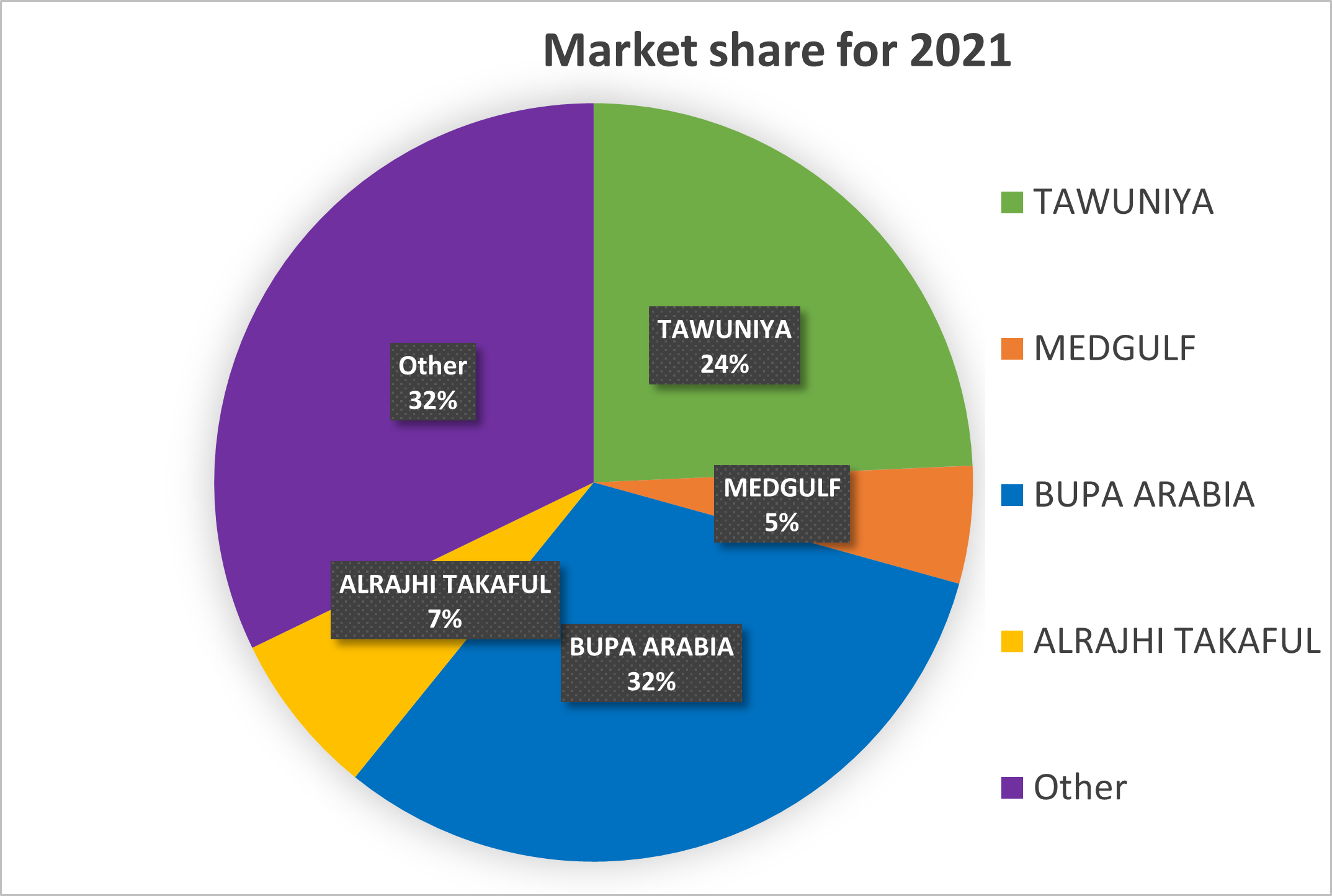
The chronology of the most important events of Bupa Arabia since the inception:
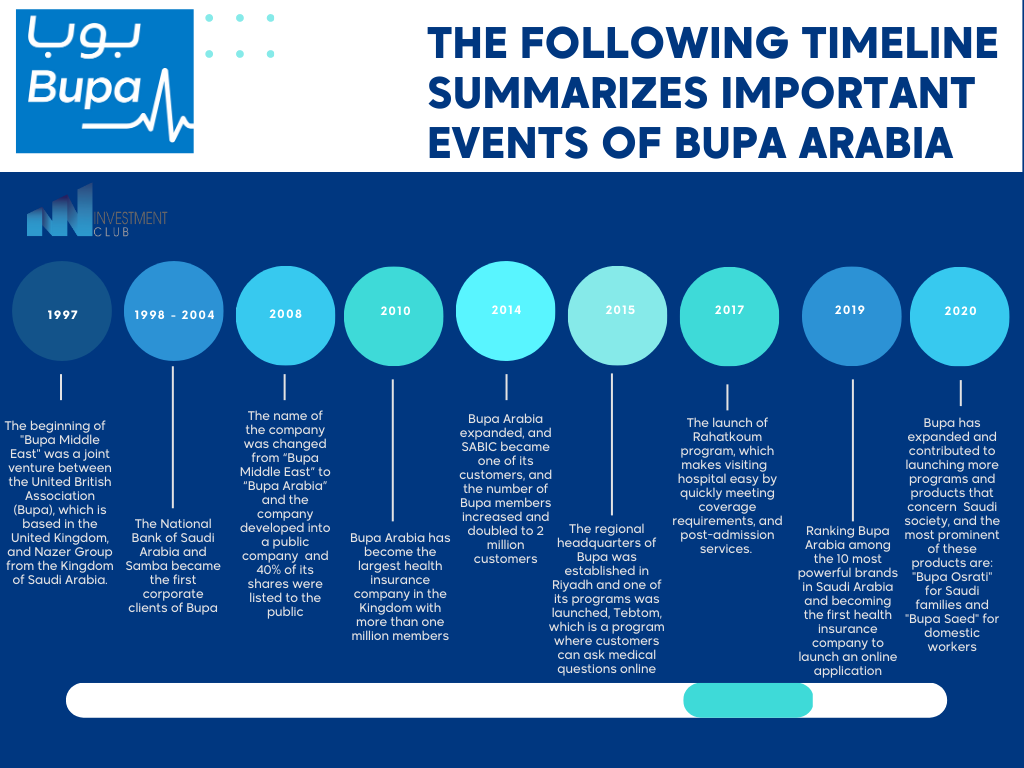
The company has several competitors, but here we will highlight the three largest companies in the sector that take medical insurance within their activities, to match the company's main activity.
1- Al Rajhi Company for Cooperative Insurance (Al Rajhi Takaful)
Al Rajhi Cooperative Insurance, known as Takaful Al Rajhi, is a Saudi joint stock, company founded in 2008/7/1. Based in Saudi Arabia specifically in Riyadh. Listed in Tadawul, with 40 million exporter shares, its market share is 7% of the total market for 2021.
The company provides insurance solutions within the framework of Islamic law provisions in line with the Kingdom's Vision 2030.
Several services are provided, including:
- General insurance:
Includes a number of products including vehicle insurance, engineering insurance, fire, public accident documents, and marine insurance.
- Health Insurance:
Includes the provision of health insurance programs for individuals and groups in line with market needs and in line with the cooperative health insurance system.
- Protection and savings insurance:
insurance and savings programmes for individuals and groups, including investment, education, retirement, group insurance and debt insurance.
2- Tawuniya
The Company for Cooperative Insurance (TAWUNIYA) was founded in 1986 as a Saudi joint stock company and was the first national company in Saudi Arabia to be allowed to engage in various types of insurance business under Islamic law and permitted cooperation principles. Its authorized paid-up capital is SAR 1.25 billion. It is considered the highest technical experience in the Saudi insurance market for more than 37 years, in addition to its acquisition of 24% market share of the total Saudi insurance market for 2021. It has the second highest market share after Bupa.
Includes over 60 types of medical insurance, vehicles, property and accidents. The company's main activity is the provision of marine insurance, fire insurance, car insurance services, medical insurance, engineering insurance, aviation insurance, takaful insurance and various accidents.
3- The Mediterranean and Gulf Insurance and Reinsurance Co. (Medgulf)
One of the largest insurance companies in the Kingdom, where it began its career in 1995 under an agency contract, was founded independently in 2006.
The company provides a comprehensive option for group and individual insurance products, including medical insurance, vehicle insurance, protection and savings insurance, vehicle insurance, and general insurance. It is controlled by the Central Bank.
The paid capital was SAR 1.050 billion, with a market share of SAR 5% for 2021.
We will review a comparison between Bupa and its competitors using Vertical & Horizontal Analysis.
Vertical analysis:
represents the relationship between two different components of the income and balance sheet statements, where the items of the statement are represented for one year as a proportion of the base value (typically total revenue on the income list, and total assets on the financial position list).
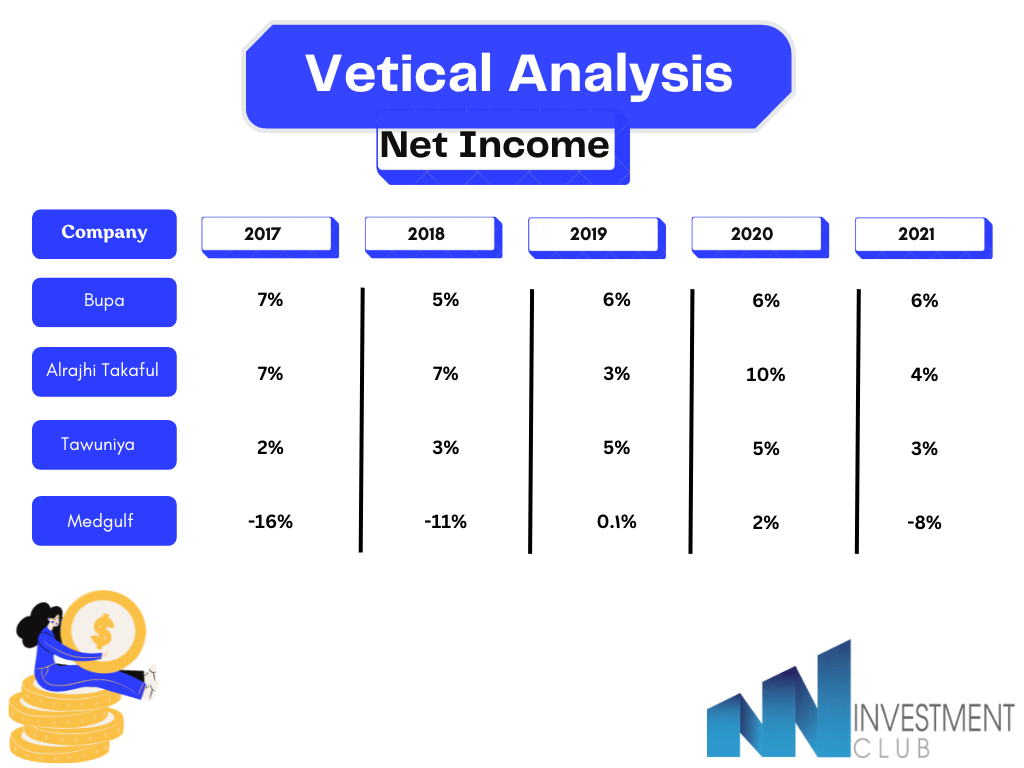
Bupa's net income-to-revenue ratio is fairly stable over the five years, reversing its competitors with little fluctuation, except for Medgulf, where it has a high fluctuation relative to its peers.
Net income for 2021 represents 5.89% of the company's total revenues and is the highest proportion of competitors, meaning that the company earns approximately 6 halalah per SAR of revenue.
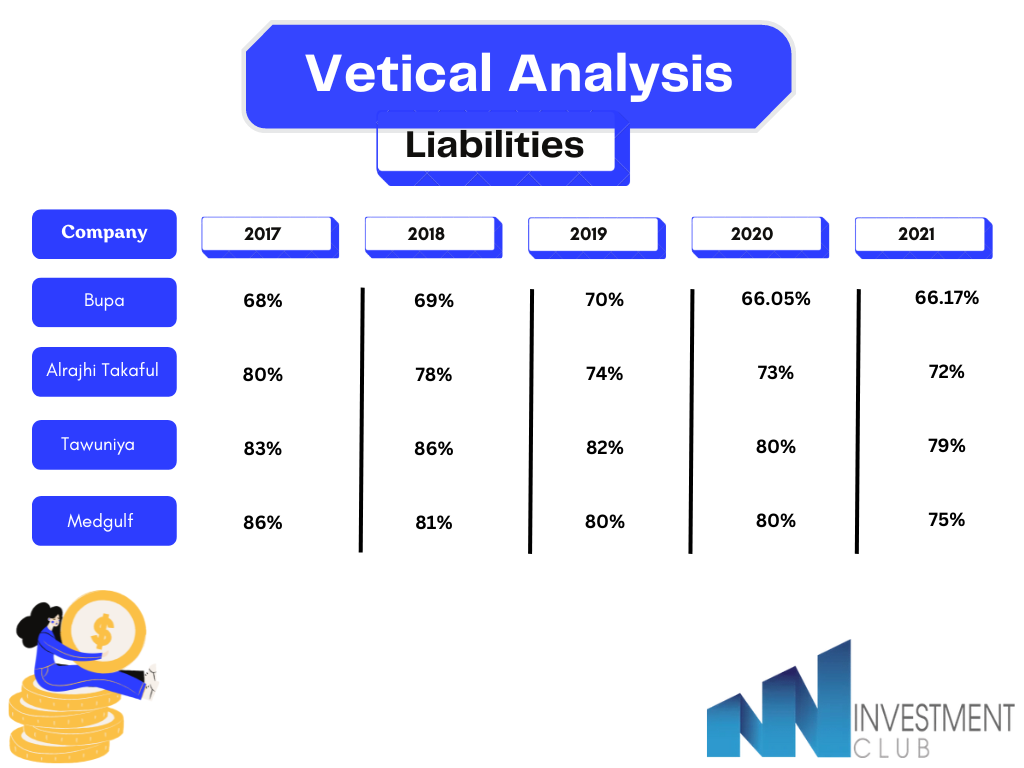
Bupa made a purchase of shares in the amount of 14.28 million riyals, with a maximum of 220 thousand shares, with a view to allocating them to its employees' program (long-term incentive plan) and financing the purchase from available cash, which justifies a slight increase in the total liability for assets to Bupa by 0.12% over 2020. Its liability-to-assets ratio for 2021 was 66.17%, the lowest among its competitors. The liability-to-assets ratio for the same year was 71.6%, 79.23%, and 75.40%, respectively, for Al Rajhi Takaful, Cooperative, and Medgolf.

Bupa's equity ratio was 33.83% higher than its competitors, meaning that its reliance on equity to finance assets is greater than its competitors. and it is the best in average asset liabilities for the past five years with a percentage of 32.12% compared to competitors.
Horizontal analysis:
Financial statement analysis is used to compare elements of income and balance sheet statements over a period. The percentage of the growth or decrease of the items for the current year is explained compared to the year before.
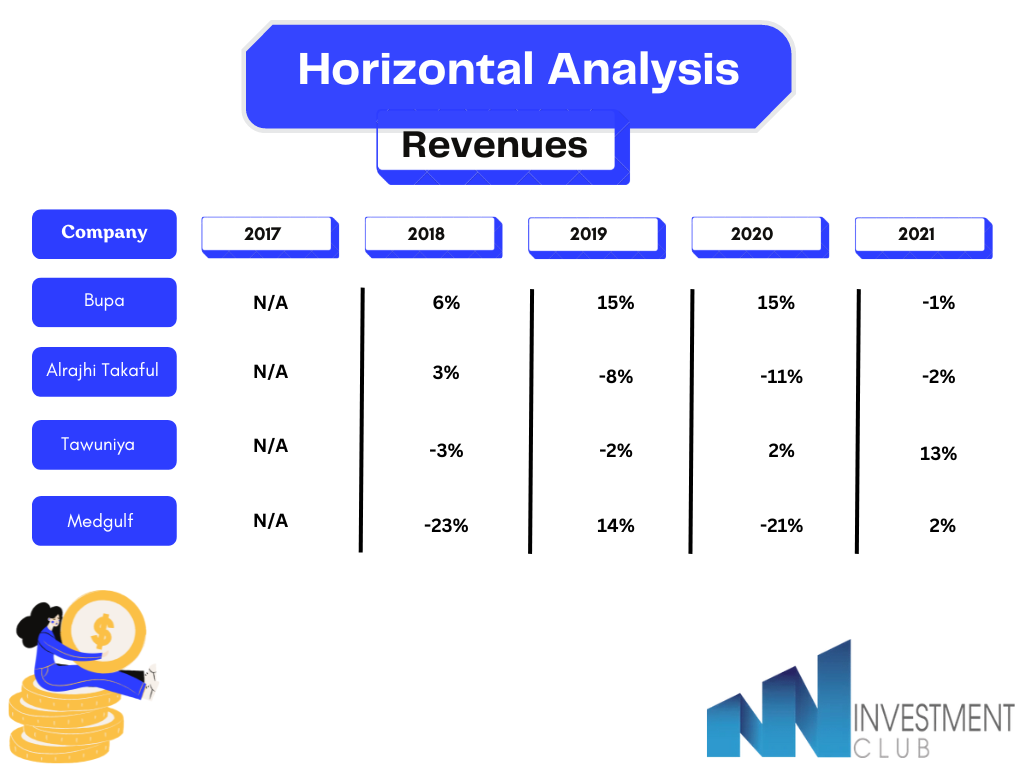
In the last five years, Bupa has achieved an average revenue growth of 9% which is the highest revenue growth compared to its competitors, due to the company's keenness to update and create different products for all members of the community.
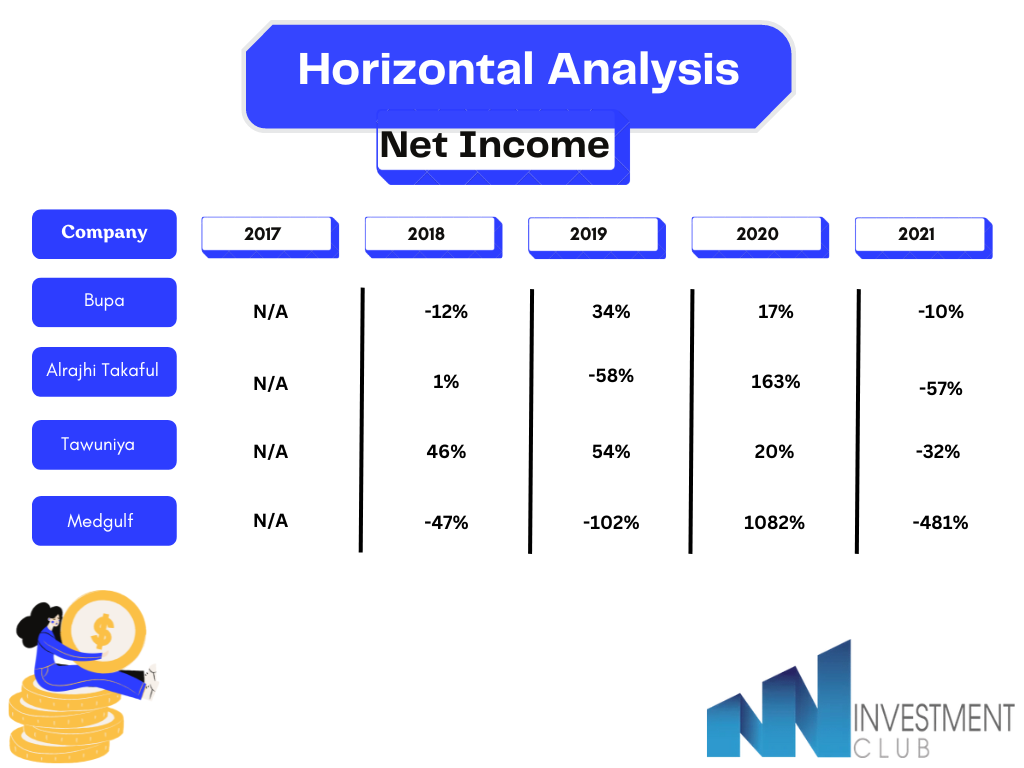
The net Bupa income decreased by -10%in 2021 than it was in 2020, and this decrease was the least among its competitors Al-Rajhi Takaful, and Tawuniya, in addition to Medgulf, where the rates of decline were 57%-, 32%-, 481%-respectively, and returns one of the reasons for the decline in the resignation of a member of the Board of Directors Joy Linton at the beginning of March, a negative impact on the results of the second quarter, in addition to Bupa's announcement of a final settlement agreement with the Public Authority for Zakat and Income with regard to Zakat and Income and deduction taxes for the years from 2008 to 2016 and the year 2018 And, with a total amount of 120.12 million riyals, but the company has made clear in a statement on 'Tadawul' that there is no fundamental financial impact expected to settle on the results of its business, as most of these differences have previously been surrounded and this has reduced this from the negative effects for this settlement.
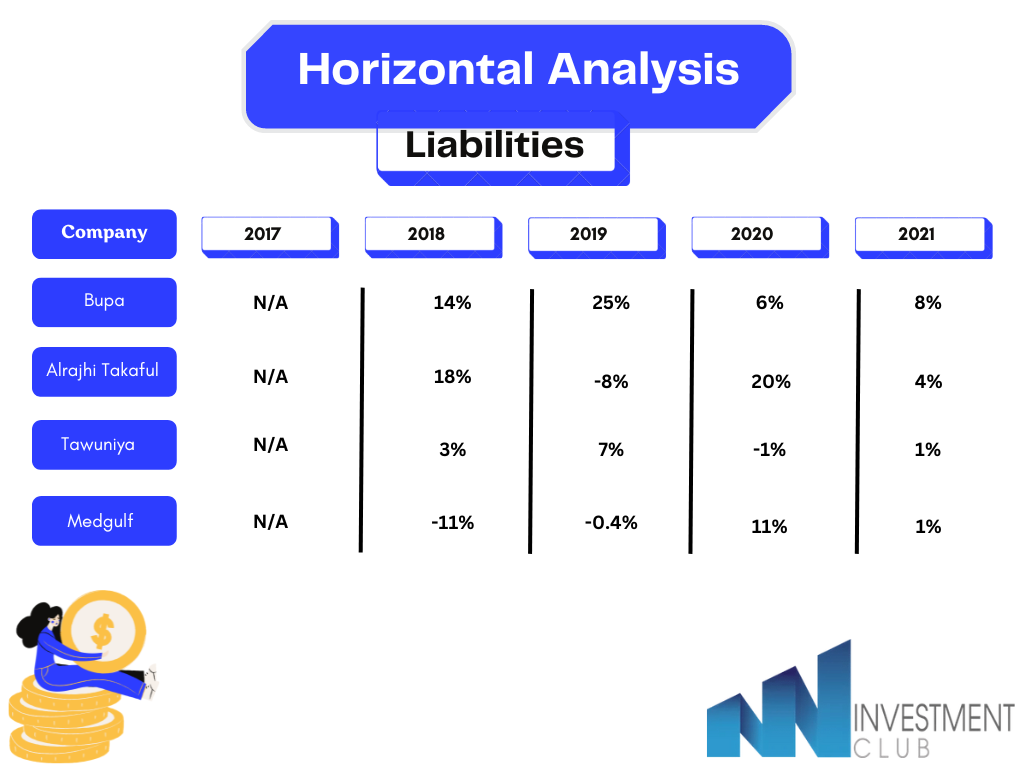
Bupa's liabilities rose in the most recent year compared to the year before, representing the highest rate of rise compared to its competitors. In addition, the average five-year change in liabilities is 13.35%, which is also the highest average among competitors, and Midgulf took first place as the lowest average change in liabilities by -0.01%.
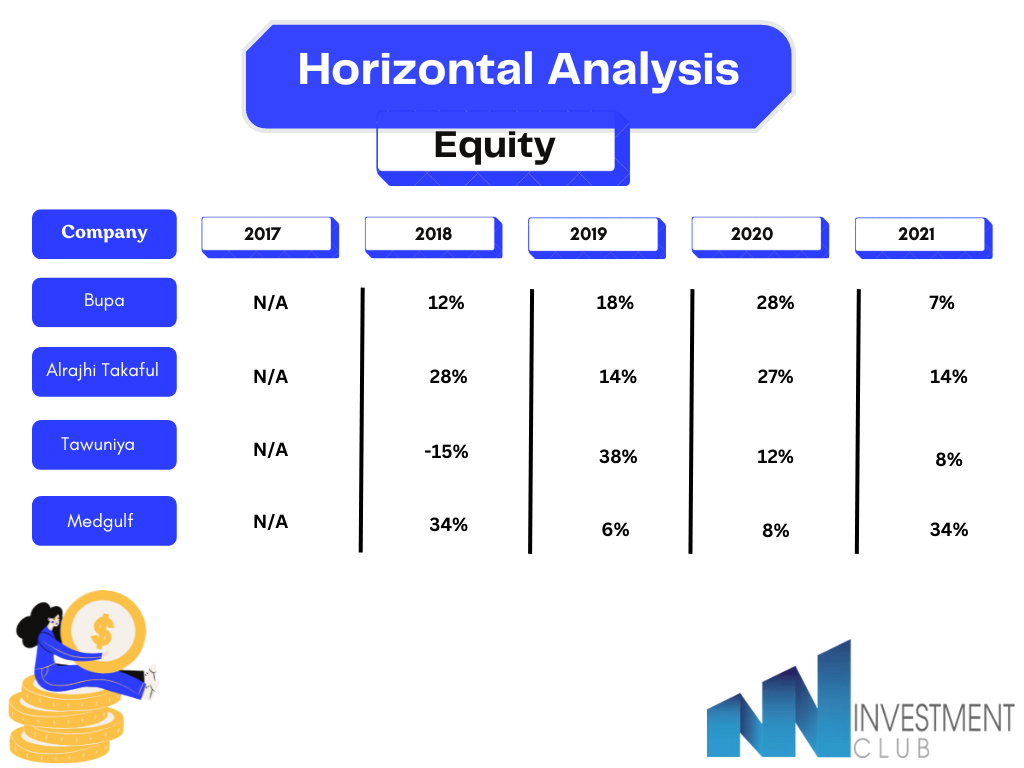
Bupa's equity rate in 2021 rose nearly 7%, representing the lowest rise compared to its competitors, with Medgulfe representing the highest rise of nearly 34%.
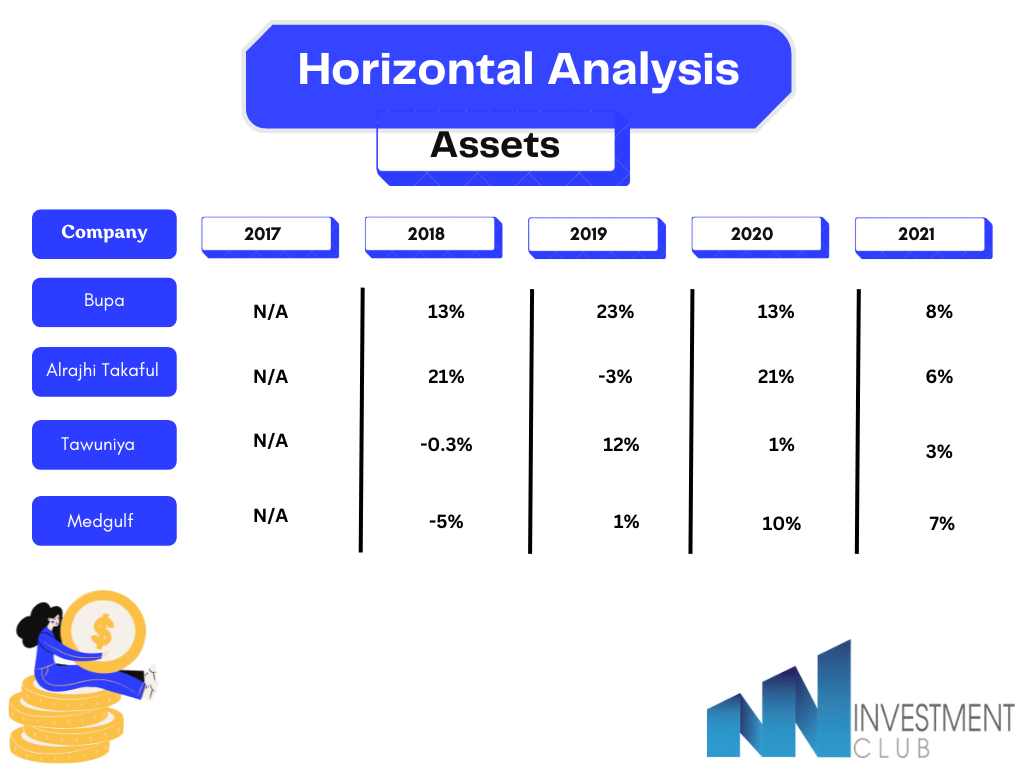
Bupa achieved a rise in assets for 2021, representing the lowest rise in five years, compared to its competitors, it represents the highest rise among them, while Tawuniya achieved the lowest rise.
Finally, we review charts showing the previous comparison:
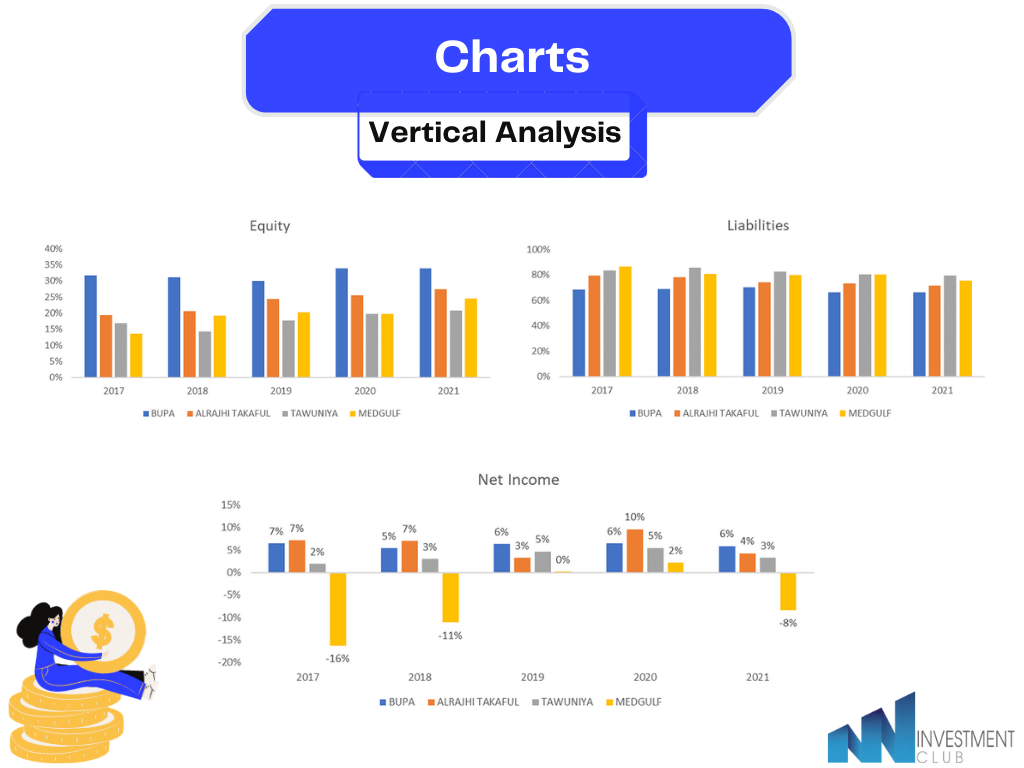
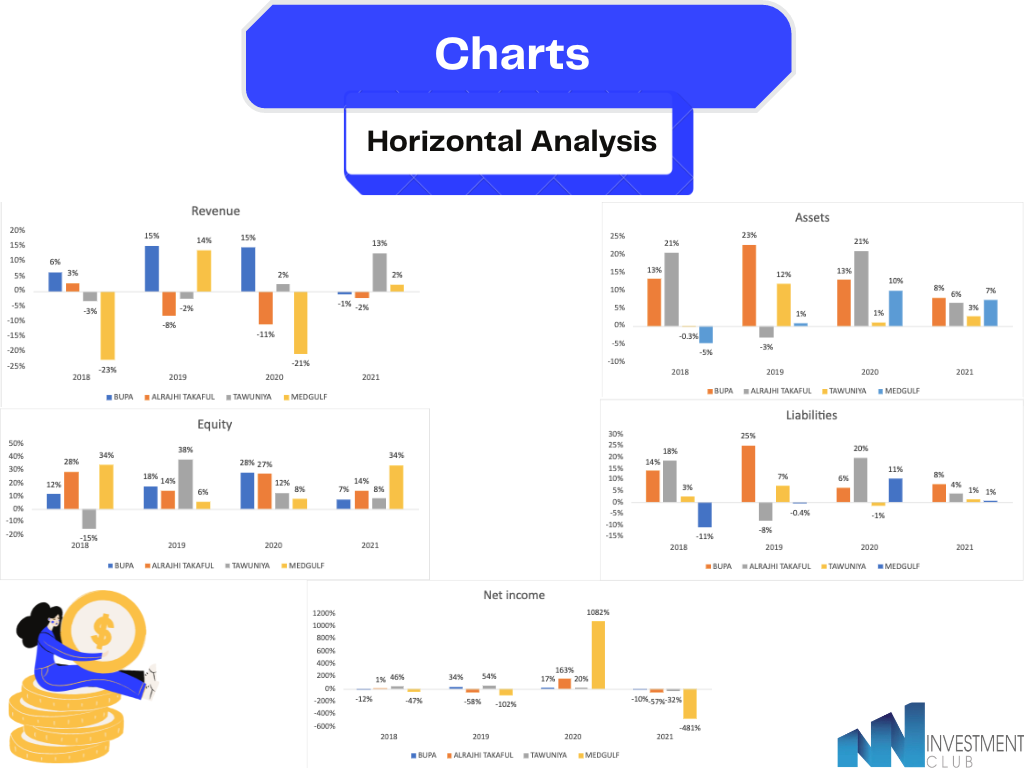
For full analysis:
Resources:
- SAMA
- IAIS SWM 2022
- https://www.saudiexchange.sa/wps/portal/tadawul/home?locale=ar https://www.bupa.com.sa/home
- Argaam
Prepared by:
Lujain Albarqan
Rahiq Mohammed
Sara Ziyad Alsalem
Amal Alqahtani
Joud Alfadhel